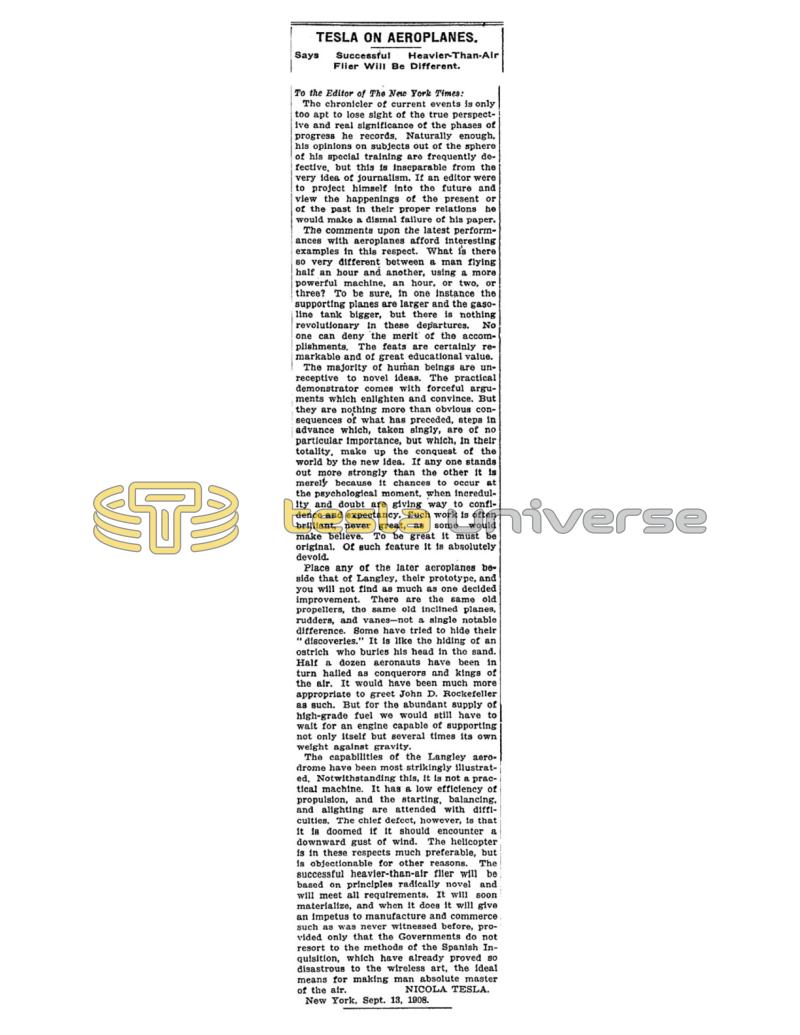
Nikola Tesla Articles
Tesla on Aeroplanes
Says Successful Heavier-Than-Air Flier Will Be Different.
To the Editor of The New York Times:
The chronicler of current events is only too apt to lose sight of the true perspective and real significance of the phases of progress he records. Naturally enough, his opinions on subjects out of the sphere of his special training are frequently defective, but this is inseparable from the very idea of journalism. If an editor were to project himself into the future and view the happenings of the present or of the past in their proper relations he would make a dismal failure of his paper.
The comments upon the latest performances with aeroplanes afford interesting examples in this respect. What is there so very different between a man flying half an hour and another, using a more powerful machine, an hour, or two, or three? To be sure, in one instance the supporting planes are larger and the gasoline tank bigger, but there is nothing revolutionary in these departures. No one can deny the merit of the accomplishments. The feats are certainly remarkable and of great educational value.
The majority of human beings are unreceptive to novel ideas. The practical demonstrator comes with forceful arguments which enlighten and convince. But they are nothing more than obvious consequences of what has preceded, steps in advance which, taken singly, are of no particular importance, but which, in their totality, make up the conquest of the world by the new idea. If any one stands out more strongly than the other it is merely because it chances to occur at the psychological moment, when incredulity and doubt are giving way to confidence and expectancy. Such work is often brilliant, never great, as some would make believe. To be great it must be original. Of such feature it is absolutely devoid.
Place any of the later aeroplanes beside that of Langley, their prototype, and you will not find as much as one decided improvement. There are the same old propellers, the same old inclined planes, rudders, and vanes — not a single notable difference. Some have tried to hide their “discoveries.” It is like the hiding of an ostrich who buries his head in the sand. Half a dozen aeronauts have been in turn hailed as conquerors and kings of the air. It would have been much more appropriate to greet John D. Rockefeller as such. But for the abundant supply of high-grade fuel we would still have to wait for an engine capable of supporting not only itself but several times its own weight against gravity.
The capabilities of the Langley aerodrome have been most strikingly illustrated. Notwithstanding this, it is not a practical machine. It has a low efficiency of propulsion, and the starting, balancing, and alighting are attended with difficulties. The chief defect, however, is that it is doomed if it should encounter a downward gust of wind. The helicopter is in these respects much preferable, but is objectionable for other reasons. The successful heavier-than-air flier will be based on principles radically novel and will meet all requirements. It will soon materialize, and when it does it will give an impetus to manufacture and commerce such as was never witnessed before, provided only that the Governments do not resort to the methods of the Spanish Inquisition, which have already proved so disastrous to the wireless art, the ideal means for making man absolute master of the air.
Nikola Tesla
New York, Sept. 13, 1908
